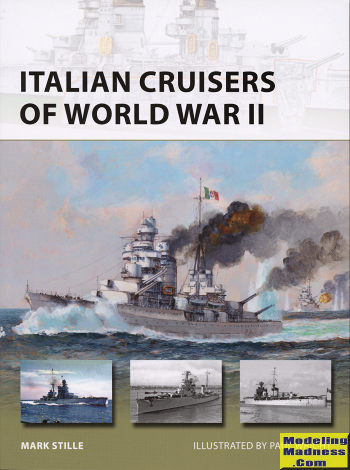 The
main purpose of the Italian fleet was to keep parity with the French. It was
also pretty much a defensive fleet as it was designed to operate in the central
Mediterranean, allowing Italy to keep open the shipping lanes between Italy, its
surrounding islands, Albania, and its North African possessions. To that
purpose, it built a series of both heavy and light cruisers to help fulfill that
mission.
The
main purpose of the Italian fleet was to keep parity with the French. It was
also pretty much a defensive fleet as it was designed to operate in the central
Mediterranean, allowing Italy to keep open the shipping lanes between Italy, its
surrounding islands, Albania, and its North African possessions. To that
purpose, it built a series of both heavy and light cruisers to help fulfill that
mission.
To my eye, these were some of the nicest looking ships of the period.
They appeared to be fast and visually well balanced designs. However, like all
warships, they were often a trade-off between speed, armament, and protection.
Italy was a signatory of the various naval treaties of the 1920s and 30s. While
they did cheat a bit on some of their later designs, they did the best they
could, as did other nations.
The initial batch of heavy cruisers sacrificed protection for speed and
armament. Interestingly, their turreted main guns did not have separate
elevation abilities but were paired together. While this did save weight, it
caused some rather odd ballistic anomalies as the shells fired from these guns
interfered with each other. This made them less accurate. Italian warships
also operated without radar, and their crews were not trained for night action,
putting them at a distinct disadvantage when operating against the Royal Navy
which did.
Italy produced three classes of heavy cruiser and five classes of light
cruiser. They also operated ex-German WWI war prizes. These ships saw more
action than most people realize, however, they were seriously hampered by the
requirement that ship captains do as much as they could to not lose their ships
in combat. Even when the Italians had the upper hand, they would break contact
and withdraw for fear of losing their ship. This meant that the enemy, in this
case the British, pretty much won every engagement and slowly eroded away at
Italy's naval power. None of this was helped by lack of radar or night combat
training.
In concert with other books of the series, we are provided the reason
for the ships that were built, the design and construction of the various
classes as well as their major equipment and modifications. Their combat record
is also featured so that we can see how the ships performed. This is
complemented by some great period photos and equally well done artwork.
Besides being my favorite Osprey series, this one is a superb look at
these important, but often overlooked ships and is a book you really need to have on your shelves.
June 2018
Copyright ModelingMadness.com. All rights reserved
For more on the complete line of Osprey books, visit
http://www.ospreypublishing.com
If you would like your product reviewed fairly and
fairly quickly, please
contact
the editor or see other details in the
Note to
Contributors.
 The
main purpose of the Italian fleet was to keep parity with the French. It was
also pretty much a defensive fleet as it was designed to operate in the central
Mediterranean, allowing Italy to keep open the shipping lanes between Italy, its
surrounding islands, Albania, and its North African possessions. To that
purpose, it built a series of both heavy and light cruisers to help fulfill that
mission.
The
main purpose of the Italian fleet was to keep parity with the French. It was
also pretty much a defensive fleet as it was designed to operate in the central
Mediterranean, allowing Italy to keep open the shipping lanes between Italy, its
surrounding islands, Albania, and its North African possessions. To that
purpose, it built a series of both heavy and light cruisers to help fulfill that
mission.